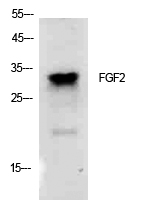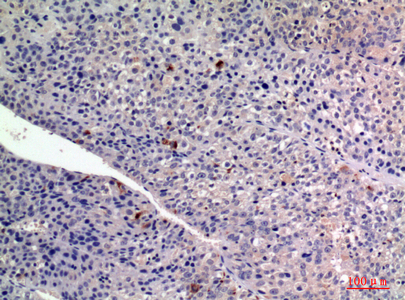FGF-2 Polyclonal Antibody
- Catalog No.:YT5549
- Applications:WB;IHC;IF;ELISA
- Reactivity:Human;Mouse;Rat
- Target:
- FGF-2
- Fields:
- >>EGFR tyrosine kinase inhibitor resistance;>>MAPK signaling pathway;>>Ras signaling pathway;>>Rap1 signaling pathway;>>Calcium signaling pathway;>>PI3K-Akt signaling pathway;>>Signaling pathways regulating pluripotency of stem cells;>>Regulation of actin cytoskeleton;>>Kaposi sarcoma-associated herpesvirus infection;>>Pathways in cancer;>>Proteoglycans in cancer;>>Chemical carcinogenesis - receptor activation;>>Melanoma;>>Breast cancer;>>Gastric cancer
- Gene Name:
- FGF2
- Protein Name:
- Fibroblast growth factor 2
- Human Gene Id:
- 2247
- Human Swiss Prot No:
- P09038
- Mouse Gene Id:
- 14173
- Mouse Swiss Prot No:
- P15655
- Rat Gene Id:
- 54250
- Rat Swiss Prot No:
- P13109
- Immunogen:
- The antiserum was produced against synthesized peptide derived from the Internal region of human FGF2. AA range:151-200
- Specificity:
- FGF-2 Polyclonal Antibody detects endogenous levels of FGF-2 protein.
- Formulation:
- Liquid in PBS containing 50% glycerol, 0.5% BSA and 0.02% sodium azide.
- Source:
- Polyclonal, Rabbit,IgG
- Dilution:
- WB 1:500 - 1:2000. IHC: 1:100-1:300. ELISA: 1:10000.. IF 1:50-200
- Purification:
- The antibody was affinity-purified from rabbit antiserum by affinity-chromatography using epitope-specific immunogen.
- Concentration:
- 1 mg/ml
- Storage Stability:
- -15°C to -25°C/1 year(Do not lower than -25°C)
- Other Name:
- FGF2;FGFB;Fibroblast growth factor 2;FGF-2;Basic fibroblast growth factor;bFGF;Heparin-binding growth factor 2;HBGF-2
- Observed Band(KD):
- 30kD
- Background:
- The protein encoded by this gene is a member of the fibroblast growth factor (FGF) family. FGF family members bind heparin and possess broad mitogenic and angiogenic activities. This protein has been implicated in diverse biological processes, such as limb and nervous system development, wound healing, and tumor growth. The mRNA for this gene contains multiple polyadenylation sites, and is alternatively translated from non-AUG (CUG) and AUG initiation codons, resulting in five different isoforms with distinct properties. The CUG-initiated isoforms are localized in the nucleus and are responsible for the intracrine effect, whereas, the AUG-initiated form is mostly cytosolic and is responsible for the paracrine and autocrine effects of this FGF. [provided by RefSeq, Jul 2008],
- Function:
- function:The heparin-binding growth factors are angiogenic agents in vivo and are potent mitogens for a variety of cell types in vitro. There are differences in the tissue distribution and concentration of these 2 growth factors.,miscellaneous:This protein binds heparin more strongly than does aFGF.,PTM:Several N-termini starting at positions 48, 54, 47 and 65 have been identified by direct sequencing.,sequence caution:Unusual initiator. The initiator methionine is coded by a non-canonical CTG leucine codon.,similarity:Belongs to the heparin-binding growth factors family.,subunit:Monomer. Interacts with CSPG4 and FGFBP1. Found in a complex with FGFBP1, FGF1 and FGF2.,tissue specificity:Expressed in granulosa and cumulus cells.,
- Subcellular Location:
- Secreted . Nucleus . Exported from cells by an endoplasmic reticulum (ER)/Golgi-independent mechanism. Unconventional secretion of FGF2 occurs by direct translocation across the plasma membrane (PubMed:20230531). Binding of exogenous FGF2 to FGFR facilitates endocytosis followed by translocation of FGF2 across endosomal membrane into the cytosol (PubMed:22321063). Nuclear import from the cytosol requires the classical nuclear import machinery, involving proteins KPNA1 and KPNB1, as well as CEP57 (PubMed:22321063). .
- Expression:
- Expressed in granulosa and cumulus cells. Expressed in hepatocellular carcinoma cells, but not in non-cancerous liver tissue.
The synergistic effect of electroacupuncture and bone mesenchymal stem cell transplantation on repairing thin endometrial injury in rats. Stem Cell Research & Therapy Stem Cell Res Ther. 2019 Dec;10(1):1-14 WB Rat 1:1000 endometrium
Effect of catalpol on behavior and neurodevelopment in an ADHD rat model. BIOMEDICINE & PHARMACOTHERAPY 2019 Aug 11 WB,IHC Rat 1:1000,1:1000 brain,prefrontal cortex (PFC)
- June 19-2018
- WESTERN IMMUNOBLOTTING PROTOCOL
- June 19-2018
- IMMUNOHISTOCHEMISTRY-PARAFFIN PROTOCOL
- June 19-2018
- IMMUNOFLUORESCENCE PROTOCOL
- September 08-2020
- FLOW-CYTOMEYRT-PROTOCOL
- May 20-2022
- Cell-Based ELISA│解您多样本WB检测之困扰
- July 13-2018
- CELL-BASED-ELISA-PROTOCOL-FOR-ACETYL-PROTEIN
- July 13-2018
- CELL-BASED-ELISA-PROTOCOL-FOR-PHOSPHO-PROTEIN
- July 13-2018
- Antibody-FAQs
- Products Images

- Western Blot analysis of K562 cells using FGF-2 Polyclonal Antibody. Secondary antibody(catalog#:RS0002) was diluted at 1:20000

- Immunohistochemical analysis of paraffin-embedded human-liver-cancer, antibody was diluted at 1:100



